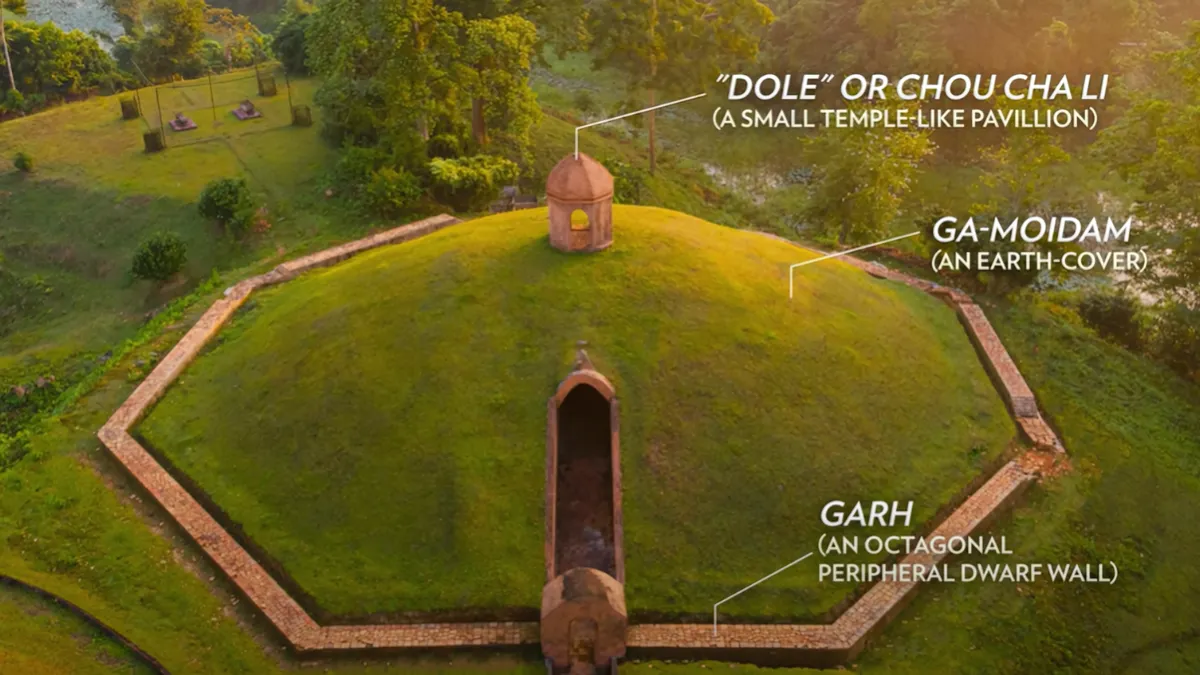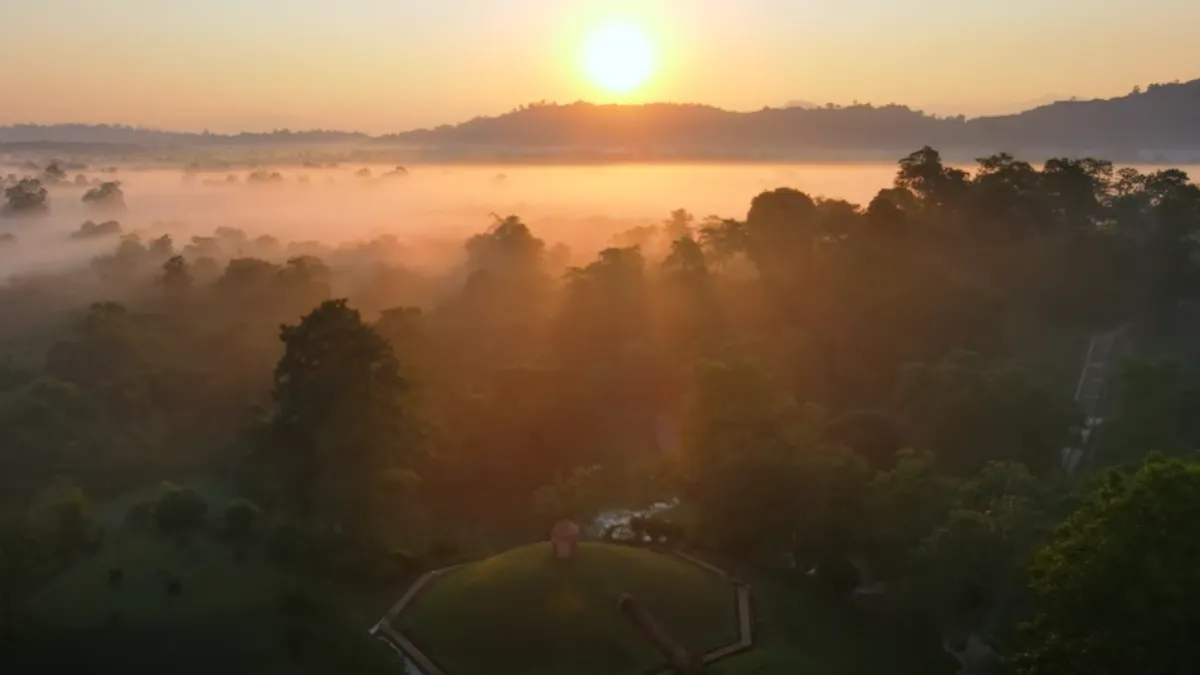Today, we’re uncovering a hidden gem in Assam that’s been keeping its secrets for ages. Welcome to Charaideo Maidam—where ancient burial mounds, are like pyramids but not in the deserts of Egypt; instead, they’re nestled in the lush hills of northeastern India. They’re not just impressive structures; they’re like a time capsule revealing the grand history and culture of the Ahom dynasty, which ruled for nearly 600 years.
And here’s the exciting news: Charaideo Maidam has just made it to the UNESCO World Heritage List, getting the global spotlight it deserves. If you love discovering hidden treasures and diving into epic history, this is the place to visit. Join us as we explore the wonders of Charaideo Maidam and see why it’s becoming a heritage sensation. For more cool and informative content, follow us on Instagram!

History of Ahoms-
The Ahom dynasty is a fascinating part of Assam’s history, beginning in the 13th century. The Tai Ahoms are believed to have come from the Yunnan region in South China. They travelled through Thailand and Myanmar before arriving in the Brahmaputra Valley. Impressed by the area’s rich and fertile land, they decided to settle and started their dynasty, with Charaideo as their first capital.
For nearly 600 years, from 1228 to the 19th century, the Ahom dynasty thrived and significantly influenced Assam’s culture and politics. During their reign, they moved their capital several times, with Sibsagar and Jorhat being among the final capitals. Their rule came to an end in the 19th century when the British arrived and signed the Treaty of Yandaboo in 1826. Even though the Ahom dynasty eventually faded, their legacy lives on through the ancient burial mounds at Charaideo. These mounds are a testament to their enduring influence and offer a glimpse into the grandeur of their reign.
Charaideo Maidam World Heritage sites in Assam

Brief Overview of Charaideo Maidam
Charaideo Maidam, located in the foothills of the Patkai ranges in Eastern Assam, is famous for its unique burial mounds, known locally as “maidams.” These mounds are special because they are the final resting places of the Ahom royalty. Unlike the traditional pyramids, maidams are earthen mounds covering intricate burial chambers. Each mound is part of a larger necropolis dedicated to the Ahom kings and queens, making Charaideo Maidam a site of immense historical and cultural importance.
Geographic Location of Charaideo Maidam
Charaideo Maidam is in the Charaideo district of Assam, a state in northeastern India. This area is known for its beautiful, green landscape, rolling hills, and its proximity to the Brahmaputra River. The region’s natural beauty provides a stunning setting for these ancient burial mounds. The site is located about 30 kilometres from the town of Sivasagar in Charaideo district, making it a serene and picturesque spot that attracts visitors interested in history and culture.
Historical Significance
Charaideo Maidam is much more than just a burial site; it holds deep historical and cultural significance. These mounds are the sacred burial grounds for the Ahom kings and queens, as well as their ancestral deities. The burial process for the Ahom royalty was elaborate and involved complex rituals. Each maidam is a testament to the Ahom dynasty’s beliefs about the afterlife and their respect for their ancestors. The site provides valuable insights into the Ahoms’ social structure, religious practices, and the blend of their Tai heritage with local traditions. These burial mounds reflect the Ahom’s rich cultural legacy and their unique funerary practices that have been preserved over centuries.
Importance of Charaideo Maidam as a UNESCO World Heritage site

Criteria for Selection
UNESCO World Heritage status is awarded to sites that have exceptional value, either culturally or naturally. Charaideo Maidam earned this prestigious recognition because it represents the unique burial traditions of the Ahom dynasty and its distinctive architecture. These burial mounds are an important part of the sacred landscape of the Tai Ahom people, showcasing their detailed rituals and beliefs.
Benefits of Recognition
Being named a UNESCO World Heritage Site brings several important advantages:
- Increased Tourism: World Heritage status often attracts more visitors. This increase in tourism can boost the local economy, providing more opportunities for local businesses and creating jobs for residents.
- Funding and Conservation: The designation helps attract international funds for the conservation and upkeep of the site. This financial support ensures that Charaideo Maidam is preserved properly for future generations to enjoy and learn from.
- Global Recognition: Gaining UNESCO status puts Charaideo Maidam on the global stage, increasing awareness about its cultural and historical importance. This global spotlight helps to highlight the significance of the site to a wider audience.
- Preservation of Heritage: The UNESCO label ensures that the site is maintained with high standards. It helps protect Charaideo Maidam from modern development that could damage its historical integrity. The site is monitored regularly, and stricter regulations are put in place to preserve its unique features and cultural value.
Overall, being a UNESCO World Heritage Site helps safeguard Charaideo Maidam’s legacy, supports its preservation, and ensures that its historical and cultural stories continue to be celebrated and understood by people around the world.
Architectural and Cultural Significance of Charaideo Maidam

Charaideo Maidam, nestled in Assam, is a remarkable site renowned for its unique burial mounds known as moidams. These structures, which resemble small pyramids, served as the final resting places for the Ahom royalty. Each maidam is an elaborate earthen mound covering a burial chamber that often contains grave goods. The mounds are topped with a pavilion called a chao chali and are surrounded by an octagonal dwarf wall, enhancing their sacred and monumental presence.
For 600 years, the Tai Ahom dynasty, which ruled Assam, created these moidams, harmonizing them with the natural landscape of hills, forests, and water bodies. This integration with nature reflects their spiritual and cultural beliefs, forming a sacred geography unique to the Ahom people. The site includes around 90 moidams of varying sizes, built from bricks, stones, or earth. Within these mounds are the remains of Ahom kings, queens, and other royals, along with valuable grave goods such as food, horses, and even elephants. Occasionally, the mounds also contain the remains of servants who were buried alongside the royalty.
The Ahom funeral rituals of me-dam-me-phi and tarpan are still practised at the Charaideo necropolis, highlighting the ongoing cultural significance of the site. Although similar moidams can be found in other parts of the Brahmaputra Valley, the ones at Charaideo are considered exceptional for their scale and preservation.
The Ahom dynasty, founded by Sukapha in 1228 AD, established these burial sites as a key part of their funerary traditions. The moidams reflect a unique blend of Tai heritage and local customs, symbolizing the Ahoms’ belief in the afterlife and ancestral worship. This practice mirrors other Asian cultures’ funeral traditions, showing a deep respect for the deceased and their journey into the afterlife. Over time, while the moidams have evolved, they continue to preserve their historical essence, offering a profound glimpse into the spiritual and cultural life of the Ahom dynasty.
Ensuring the Preservation of Heritage-The Impact of UNESCO World Heritage Status

Achieving UNESCO World Heritage status plays a crucial role in the preservation of cultural sites, ensuring that they are maintained and protected for future generations. Once a site earns this prestigious recognition, it is subject to international conservation and management standards. This means regular monitoring and stricter regulations are put in place to oversee any development projects in the area. Local authorities are given increased responsibilities to maintain the site’s integrity and historical value.
In India, numerous sites hold this esteemed designation, each representing a unique aspect of the country’s rich cultural heritage. The iconic Taj Mahal, renowned for its stunning architecture and love story, the historic city of Jaipur with its unique urban planning, and the magnificent Ellora and Ajanta caves, known for their ancient rock-cut temples and monasteries, are just a few examples. The 13th-century Sun Temple in Konark and the architectural marvel of the Qutub Minar and its surrounding monuments further highlight India’s diverse and rich history.
With Charaideo Maidam now added to this list, the legacy of the Ahom dynasty will be preserved and celebrated on a global stage. This recognition ensures that the remarkable burial mounds of Charaideo Maidam, which embody centuries of history and culture, are safeguarded against modern threats and maintained with the highest standards of preservation. The UNESCO status not only helps protect these ancient structures but also raises global awareness about their historical significance, attracting scholars and tourists from around the world to learn about and appreciate the fascinating heritage of the Ahom dynasty.
So, if you’re up for a unique adventure, add Charaideo Maidam to your travel bucket list! This hidden gem isn’t just about ancient burial mounds. it’s a portal to the epic story of the Ahom dynasty and a testament to their rich heritage. Witness the magic of these ancient pyramids, explore their mystical surroundings, and immerse yourself in a piece of history that’s now celebrated globally. Trust me, a visit to Charaideo Maidam will be an unforgettable experience that connects you with the past and showcases the remarkable legacy of Assam. Don’t miss out on this chance to witness a true cultural treasure.
FAQ:
How many UNESCO sites are in India?
India boasts 42 UNESCO World Heritage Sites, ranking it as the 6th country with the most sites worldwide. Out of these, 34 are cultural, 7 are natural, and there’s one mixed site—Khangchendzonga National Park.
Is Charaideo Maidam a UNESCO World Heritage Site?
Yes, Charaideo Maidam just made it to the UNESCO World Heritage list as a ‘cultural property.’ This means it’s recognized for its amazing cultural value and the epic history of the Ahom dynasty.


